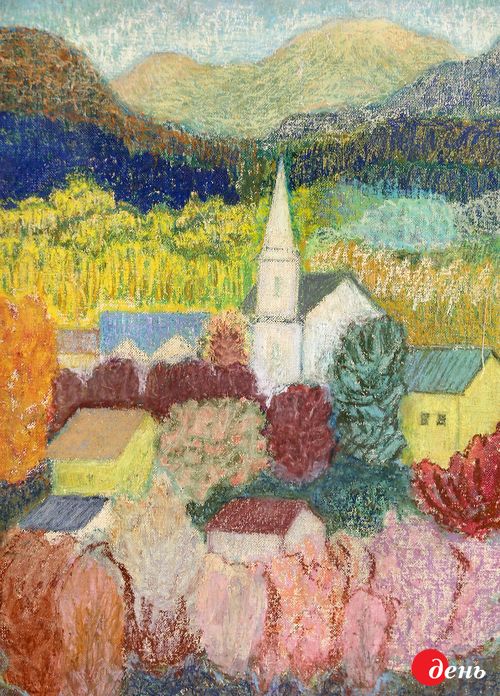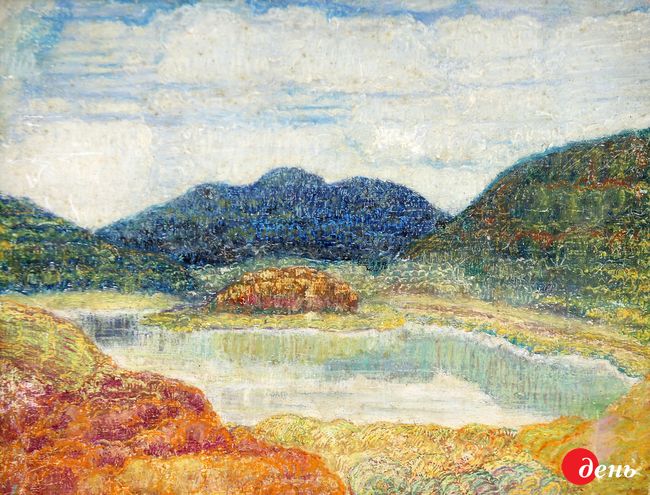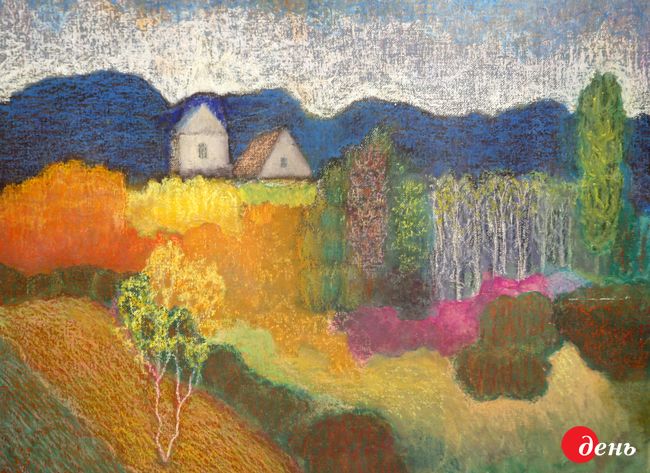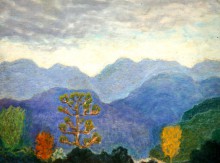Our legendary writer and translator was also an outstanding artist whose works are not worse than those of the “visionary” Ciurlionis. Words fail me. For we saw a wonder with our own eyes – an exhibit that even history schoolbooks are sure to mention. The point is that Ukraine now has its own Ciurlionis or Roerich, only without a trace of sweetish “Oriental” mysticism and exotica.
For the first time in history, thanks to the efforts of the commission on returning national cultural treasures to Ukraine, the National Museum of Ukrainian Literature has opened the exhibit “The World through the Eyes of Soul: Vasyl Barka’s Paintings.” This exposition is now displaying 21 artworks by the outstanding writer Vasyl Barka (real name Vasyl Ocheret, 1908-2003) – landscapes painted with the pastel technique in the 1960s in the US. This exhibit is sure to go down in the annals of history for two reasons: firstly, because Ukraine has at last discovered Barka as an artist, and, secondly, owing to the artistic quality of the famous prose writer’s, poet’s, and translator’s creative achievements.
We know that Barka, a prominent writer, the author of The Yellow Prince, the world’s first novel about the Holodomor, a lot of poems and essays, was also a Christian mystic. His collection The Horseman of Heaven is full of Christian-centered theological reflections. It is written in all the writer’s biographies that he studied at a “seminary.” It is also emphasized that he was forced to publicly repent in 1930 for an attempt to restore a religious “vestige of capitalism” in his works (this occurred at a meeting of the Ukrainian branch of the Russian Association of Proletarian Writers). It is well known that Barka, as a linguist, wrote and defended – in 1940 in Moscow – a Candidate of Sciences dissertation about Dante’s Divine Comedy. But it is less known that he worked at the same time at the Krasnodar Art Museum.

“My service at the museum ended up in a catastrophe – I was put on trial,” the artist says in his autobiography, “although there were no sufficient grounds. After finding information about the pictures to be displayed, I chose for the exposition Duerer’s engraving Man of Sorrows (flagellation of Christ), the copy of a picture of Ivanov (the author of The Appearance of Christ before the People), the copies of Veronese’s Pieta, Raphael’s Madonna with St. George, Correggio’s Holy Night (Nativity), and a number of other religion-themed pictures of a true artistic values from the museum’s holdings. The court accused me of making a ‘counterrevolutionary design of the art museum.’”

Vasyl BARKA, THE CENTER OF A VILLAGE
The conclusion is that Barka carried his love of Dante and religious painting from his childhood onwards. As he writes, The Divine Comedy, illustrated by Gustave Dore, was one of the first “adult” books he, a country boy, read in addition to Shevchenko’s Haidamaky. As for his “first artistic impression” in life, the autobiography says: “Father commissioned an itinerant deacon-painter to draw the icon ‘Prayer of the Chalice’ on a big sheet of roofing iron: Christ stands near a rock among the sad trees in the Garden of Gethsemane. The image occupied the whole icon corner in the house.”

Yet Vasyl Barka, as an artist who resembles Ciurlionis and Roerich in his choice of colors, a visionary artist whose paintings also explain and complement his prose, is a discovery indeed. You can’t possibly avoid this association when you look at small-size landscapes the author painted on little wood boards and strengthened with varnish. A marvelous, almost heavenly, peace of nature on the pictures resembles Ciurlionis’ Paradise as well as perhaps De Chirico. Even the colors are similar: ocherous, yellow, green, navy blue, and red “undiluted” paints. The inclination towards geometry resembles the artistic manner of De Chirico. Yet there are no angels on the canvases – only the trees frozen in eternity. And the mountains on one of the landscapes look the Roerich’s Tibet. But what became a Shambhala for Barka as artist are the American mountains that miraculously resemble the Carpathians. The writer lived his last years in Glen Spey, New York, at the Verkhovyna nursing home of the Ukrainian Fraternal Association. His cabin, which he built by himself, was hidden behind a wall of boulders. He lived the life of an outright recluse who contemplated nature and reflected on God. The artist left to the world not only prose and poetry, but also some meditative pictures. When you look at these pictures, you seem to be absorbed in meditation and feeling the touch of heavenly eternity. You seem to hear a quiet conversation with God in the language only saints and angels can speak – one of serene sensations and godly images.

Vasyl BARKA, A MOUNTAINOUS ESTATE
“This exhibit is the first in the history of Ukraine. Our museum is very proud of being lucky to keep and display Vasyl Barka’s uncommon and really beautiful paintings,” says Raisa SENNIKOVA, deputy director general of the National Museum of Ukrainian Literature for research and education. “The pictures, a bit spoilt in the course of time and transportation, were first restored at the Central Restoration Workshop. We are planning to display them at various exhibits as well as to finish the making of a permanent exposition of the 1960s period and supplement the section about Barka. There will be more than twenty pictures.”







